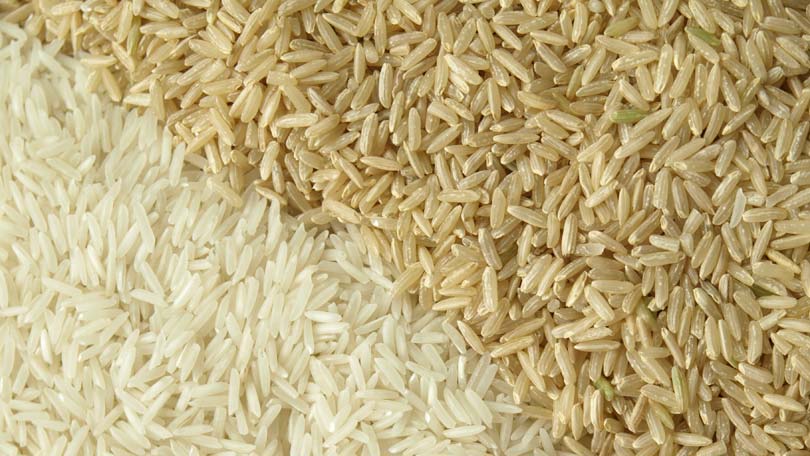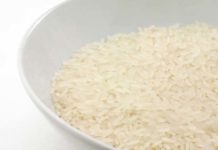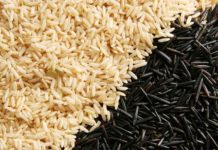
There has been a lot written about the nutritional comparisons of white rice vs brown rice. Like most things, the issue is much more complicated than it would initially seem. The first problem is that we have to settle on what we call ‘white’ rice and ‘brown’ rice. There are over 40,000 varieties of rice grown worldwide, and several dozen types in the US. They come in shades from pale white to plum purple and black. Over 500 varieties could be said to be ‘white’. To further confuse the issue, there are long grain, medium grain, and short grain varieties. Most commercial rice in the US is simply called American Long Grain (or Medium Grain) Rice, which is just a generic term for US produced rice.
In the US, when we talk about white rice and brown rice, we are usually referring to the milled, and unmilled versions of the same type of rice. Unmilled rice has the bran and germ still intact. White rice has had the bran and germ removed, leaving only the endosperm. Most commercial rice in the US is of the Calrose (short for California Rose) species. This is what you get when you buy Uncle Ben’s, parboiled, Rice-A-Roni, etc….The original Calrose species (USDA # C.I. 8988) was replaced by a hybrid version in the 1970s, but it is still called Calrose. It makes up over 90% of all the rice used in the US, and is so popular overseas that there is a Black Market for it. The US Long-Grain rice is Texmati, a US version of Basmati Rice. Both varieties come in brown, and white versions.
Now, we can begin to compare the two versions of the most popular rice species in the US, Calrose. As we said earlier, the white rice has had the germ and bran removed. It makes a very pretty white grain, but many of the nutrients are lost with the bran and germ.
Nutritional Comparison of White vs Brown Rice
| Calrose White Rice, 1 cup-cooked | Calrose Brown Rice, 1 cup-cooked |
|---|---|
| Calories: 205 | 216 |
| Carbohydrates: 44.5g | 44.8g |
| Omega 3 Fatty Acids: 20.5mg | 27.3mg |
| Omega 6 Fatty Acids 98mg | 603.0mg |
| Protein: 4.2g | 5.0g |
| Fiber: 0.6g | 3.5g |
| Vitamin A: 0 | 0 |
| Vitamin C: 0 | 0 |
| Vitamin D: 0 | 0 |
| Vitamin E: 0.1 mg | 0.1mg |
| Vitamin K: 0 | 1.2mcg |
| Thiamin: 0.3mg | 1.8 mg |
| Riboflavin: 0 | 0 |
| Niacin: 2.3mg | 3.0mg |
| B6: 0.1 mg | 0.3mg |
It’s pretty obvious from the charts that brown rice has more nutrients. But is this really significant? After all, in the US, rice is hardly ever eaten by itself. Can’t the shortages in the white rice be made up with the side dishes? Of course, and it usually is. Add to that the fact that many producers also ‘enrich’ their white rice with vitamins to offset some of what is lost during milling. The differences in calories are slight, and most likely beyond notice. Studies have shown that using brown rice instead of white does lower the risk of Type II Diabetes, and does help with weight control, but they are not sure why, yet. The studies are still ongoing. All other things being equal, I haven’t heard of anyone in the US dying from malnutrition because they ate white rice. The differences between white and brown rice would only be really significant if all you ate was rice. If you live in Asia, unfortunately, this could actually be the case.
The question is significant to persons living in Asia because in many places, there is a social stigma associated with brown rice. It is a symbol of poverty, and shortages. Only the elderly, and very poor will eat brown rice. Since rice makes up the bulk of their diet, especially for the poor, the very people who could benefit most from brown rice, will not eat it. This does lead to nutritional diseases, and has always been a problem in the East, especially for sailors.
Prior to the late 19th Century, it was well known that Asian sailors suffered a high rate of beriberi, although the cause was not known at that time. In 1873, a Naval doctor for the Dutch East Indies Company observed that European crewmen suffer far less incidences of beriberi than Asian sailors. The only difference was that the Asian sailors preferred a diet mostly of polished white rice, while their European shipmates ate meat, brown rice, gruel, vegetables, or whatever was available. Later experimentation (on domestic fowl, not people…) proved that beriberi was, in fact, a nutritional disease, and easily cured by varying the diet. In 1911, the exact cause, and cure was isolated as the vitamins Niacin, and Thiamine.
Brown rice has almost 6 times the amount of thiamin as white rice. Another benefit of brown rice is that it has a lot more Omega 3 and Omega 6 Fatty Acids. These can absolutely lower bad cholesterol. Also, brown rice has more essential minerals than white rice. So it is more than just a calorie and vitamin-counting thing. Your body is very complex, and requires a lot of things besides vitamins and calories. It these areas, brown rice is the uncontested winner. The majority of minerals in any grain are in the bran and germ.
OK. So brown rice is superior to white from a nutritional standpoint. But what about from a culinary aspect? Non-glutinous, long-grain white rice has a slightly chewy texture (when not over-cooked), and a nice clean, neutral taste that goes with just about everything. Medium-grain has a slightly less chewy texture. Both are wonderful in soups, meatloaf, and other dishes to provide bulk and body, without changing the taste of the food. On their own, they makes a great side dish, and take on the characteristic flavors of whatever they are served with. White rices are very user-friendly grains. This Arroz con Leche Recipe with Basmati Rice | Mahatma® Rice is a great way to introduce yourself to a tasty rice pudding. Brown rice takes longer to cook, is wonderfully chewy, and has an outstanding nutty flavor that can enhance most things it is served with. It will add that flavor to whatever it is cooked in, so it might not be as good a choice as white rice for some soups, and other dishes, unless you actually want that exotic nutty flavor in it. It is perfect for making meat substitutes, especially when mixed with bulgar wheat. Brown rice leaves you feeling more full than white rice, and for a longer period of time. It is more satisfying, ounce-for-ounce.
In conclusion, in the battle of white vs brown rice, it would seem that you are in no danger of contracting a nutritional deficiency from eating white rice. Brown rice is the clear winner in the nutrition department, but will you get skinny from switching to brown rice? Probably not. Will you get diabetes from eating white rice? Probably not. The truth is actually what we’ve known for thousands of years. The key to staying healthy is a varied diet and exercise, all within reason. If you like white rice, it wont hurt you to enjoy it, in moderation. If you like brown rice, you should feel free to indulge yourself when you want, also within reason.


